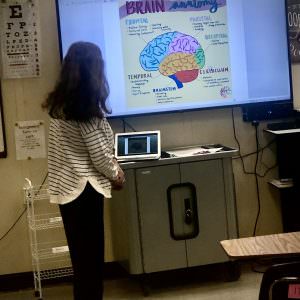Cynthia Cresap – TOY
The topic of teaching has been in the news often over the last few years. In the spring of 2020, COVID-19 disrupted the world of education and continued to drastically affect teaching and learning within a physical space. Teachers had to adjust to disseminating lessons online and teaching students through a computer screen. Students had to do their best to stay engaged while sitting in their dining rooms or on their couches and communicating with their teachers via Zoom. An already challenging job became nearly impossible. Many teachers understandably left the profession. The ones who stayed, however, made the best of an undeniably difficult situation.
Because of the challenges that COVID-19 created in schools and districts across the country, the value of teachers should have risen. Unfortunately, that hasn’t been the case universally speaking. In other words, good teachers are hard to find. Haywood County Schools (HCS) is quite fortunate, though, to have many high-quality teachers teaching across the district.
This past fall, HCS announced building level teachers of the year. Out of those teachers, three were selected as grade band teachers of the year and were placed in the divisional pool (West, Middle, East Tennessee) with the opportunity to be recognized on the state level. The grade bands were divided into three groups based on grade levels: Pre-K – 4, 5-8, 9-12. Each of these grade bands offer specific rewards and challenges when teaching that particular age group, but are of equal importance when it comes to educating students.
The grade band teacher of the year for grades 9-12 is Haywood High School Health Science teacher, Cynthia Cresap.
 Cynthia is relatively new to the field of education. Before entering the classroom, Cynthia spent her time as a nurse living and working in Memphis. This semester she is teaching Anatomy and Physiology to students at Haywood High School.
Cynthia is relatively new to the field of education. Before entering the classroom, Cynthia spent her time as a nurse living and working in Memphis. This semester she is teaching Anatomy and Physiology to students at Haywood High School.
“This is my fourth year teaching, and I’m teaching Anatomy and Physiology,” she said. “I think teaching is a calling because I never planned on doing this. I was a nurse working and living in Memphis. My husband grew up in Haywood County and we were wanting to get out of Memphis, so we started building a house on the land where he grew up. I just thought I’d work two or three days a week at LeBonheur…just work part time and drive back and forth to Memphis.”
Shortly after moving to Brownsville, however, her plans changed fairly quickly.
“A friend of mine told me about this teaching position at Haywood High School. I prayed about it, and it just fell in my lap,” she explained. “I thought I wanted to possibly work in hospice because empathy and compassion are my thing, but now I’m really understanding that those two emotions are very helpful as an educator.”
Most teacher preparation programs focus on the science of teaching – strategies and pedagogy. However, the intrinsic values and social-emotional awareness of educators has proven to be the most important factor when it comes to learning. If students know a teacher cares for them as people and not just a test score or a name on a class roster, a relationship can begin to form that opens the door to honest and authentic communication.
“I know ‘social-emotional’ is a relatively new buzzword, but that’s just who I am. I think that’s why I’ve worked well here. It’s just natural for me to be that way,” she said. “The students who know me know this isn’t a facade. I tell them the truth. I tell them who I am, what I’ve done, the struggles I’ve experienced. When they have issues, I have the rule that if they’re upset about something, they can tell me and they can call home to talk to someone or talk to me or put their head down if they need to do that. We all have bad days sometimes, and things happen outside of school that are upsetting.”
“The students who know me know this isn’t a facade. I tell them the truth. I tell them who I am, what I’ve done, the struggles I’ve experienced. When they have issues, I have the rule that if they’re upset about something, they can tell me and they can call home to talk to someone or talk to me or put their head down if they need to do that. We all have bad days sometimes, and things happen outside of school that are upsetting.” – Cynthia Cresap
Understanding the emotional needs of students and then empathizing with them and allowing them to communicate why they’re upset is part of a new and effective way of classroom management. Gone are the days of inflexible, authoritarian discipline. An empathetic ear builds relationships and trust, and once those are in place, walls begin to be broken down.
“I had a student who was so disruptive the other day, but she respects me and we have a relationship so I was able to talk to her in the hall and have a real conversation about what was going on with her. She started crying and told me some of the things that were happening in her life outside of school, and we were able to talk about it and move forward. I think those are the things that our students need,” she said.
Cynthia has noticed some of the social challenges that have arisen after two non-traditional years of learning because of COVID. This school year has been the students’ first full year of in-person learning since the 2018-2019 school year. Being back around each other on a day to day basis has been an adjustment, and one that has sometimes been stressful. Cynthia sees a lack of communications skills between students as a catalyst for some of the behavior problems that have occurred this year. She also believes that the advisory program, Facing History in Ourselves, at Haywood High School is helping bridge some of those gaps.
“A lot of issues we see in school start on social media or in the students’ neighborhood – basically outside of school. And, now we’re all back together full-time and some of these issues are culminating in the schools,” she explained. “I think having two non-traditional school years due to COVID has really impacted students on a lot of levels and that includes their behavior within school. If we want to do something for our students, we really need to teach them to communicate. I think that’s what advisory groups are trying to do – give the students a safe space to communicate about difficult topics. I love our advisory program.”
“If we want to do something for our students, we really need to teach them to communicate. I think that’s what advisory groups are trying to do – give the students a safe space to communicate about difficult topics. I love our advisory program.” – Cynthia Cresap
Cynthia’s advisory group this year consists of ninth grade students. Since she’s a high school teacher, this is her first exposure to these students and their first exposure to her. She likes to form her opinion about her students rather than hearing what they were like from other teachers the students may have had in the past. She also prefers to have ninth and tenth grade students in class because she believes they need a little more discipline and structure than the upperclassmen. And even though Cynthia is an empathetic person, she also considers herself a disciplinarian and those two things can definitely co-exist. In fact, empathy and discipline compliment each other very well.
“I always ask to teach ninth and tenth grade because I’m a disciplinarian, but one that does it with love,” she explained.
 As teacher of the year, Cynthia has found effective ways to build relationships with students while also imparting knowledge of the curriculum to them. She also knows that she is more than just a teacher of health science and that in order for students to learn as much information as they can, students have to also learn soft-skills to maximize intellectual learning.
As teacher of the year, Cynthia has found effective ways to build relationships with students while also imparting knowledge of the curriculum to them. She also knows that she is more than just a teacher of health science and that in order for students to learn as much information as they can, students have to also learn soft-skills to maximize intellectual learning.
“I’m constantly thinking about how to get kids to think,” she said. “A good teacher has to be caring; they have to have empathy. I try to teach kids empathy. Teachers have to be goal-oriented and communicate those goals to their students. Teachers have to be responsible in order to teach their students responsibility. We’re not just teaching curriculum; we’re teaching life skills, too.”
Being a teacher, Cynthia has seen some overlap between her old profession of nursing and her current profession of teaching.
“The commonality that overlaps both education and healthcare is that both are care-giving professions. You have to be a caregiver to be a nurse as well as a teacher. I’m definitely an empathic person; I could feel when my patients were hurting, and I can feel when my students are struggling, too,” she said.
“The commonality that overlaps both education and healthcare is that both are care-giving professions. You have to be a caregiver to be a nurse as well as a teacher. I’m definitely an empathic person; I could feel when my patients were hurting, and I can feel when my students are struggling, too.” – Cynthia Cresap
Because she can sense when her students might be struggling, she wants them to be comfortable enough to talk to her about what is bothering them if they feel the need. She also wants them to remember her as a teacher who had high expectations for them and expected them to learn.
“I want my students to know that I care about them, and that I know they can succeed. I tell them ‘Everything is easy once you know it’, but learning anything takes effort. I want them to remember that I expected them to work hard,” she said.
Along with the expectation of hard work and learning, Cynthia also wants to teach her students to be their own advocates – to fight for what they deserve and what they need.
“I want to teach my students how to advocate for themselves. I want them to be self-aware. I’ll send students to talk to someone if there’s a problem with their schedule. I want them to fight for themselves when it comes to something that’s important to them like their program of study for example. Our advisory groups help a lot with that, too, thankfully.”
As Cynthia is winding up her fourth year of teaching, she has a healthy perspective on her role as an educator. The stress of teaching is different from the stress she felt in healthcare, but that difference has given her a balanced viewpoint of what it means to be an effective educator.
“Nursing was more stressful than teaching because it was literally life or death at times. Teaching, though, is a lot more emotionally taxing than I thought it would be. I’m a very serious person, but I know that teaching isn’t life or death. I’m serious about learning, though, and I think my students know that,” she said.
While Cynthia’s path to the career of education wasn’t traditional, it definitely seemed to be fated. The intrinsic qualities she brings to the classroom have helped her earn the trust and respect of students as well as earn the teacher of the year award for 9-12 grades in Haywood County.


